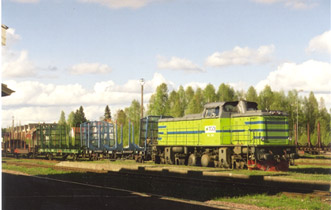
A TGOJ T43 resting for the weekend in Orsa, August 2001. See more in Ollies trainstuff!, all colorphotos by Ollie Ahokas
E, E2

A preserved E-class engine in Grängesberg. This engine sports a a typical combined steam and sand dome found on most of Swedish engines.
Photo and scan by Ollie Ahokas
One of the most long-lived were the E-class which were designed with the Inland line in mind dates from 1907 130 engines were built, of which 14 were sold of to private owners before 1927. The engine received configuration as 0-8-0, to be able to get maximal traction on 12.5 tons of axle loading. This gave the engine same starting power as the heavier 4-6-0 of the B-class. The maximum speed was 65 km/h, and this was considered sufficient to use the E-class engine as power for passenger trains on secondary lines. As the most of the engines were stationed in Northern Sweden they received closed cabs and improved isolation. One feature that is unusual for designs of State Railways is that the cylinders of diameter of 500mm each are placed inside the frame giving the engine a rather naked appearance; the other designs were the A-class Atlantics from 1906 and the light J class 2-6-4T. But the inside cylinders were rather common on designs on the various privately owned lines.

A preserved E2-class engine in Grängesberg. This engine sports the typical steam and sand dome found on E-class and E2-classes.
Photo and scan by Ollie Ahokas
The reasons for the design for the E - class was to reduce weight, though it meant harder to service valve-gear. The performance needed to be improved and number of the engines were rebuilt in to 2-8-0.s and these engines were reclassified as E2. Though they were designed with Inland line in mind, they eventually ran almost everywhere in Sweden, and during the twilight of steam stationed from southern Sweden to North, used on the post war nationalized privately owned lines and replacing ageing odd designs on these lines as well as for any secondary duties on the mainlines as power for local freights and as power for work trains. It was also used on larger yards as switchers, but on these assignments replaced by diesels in the fifties and early sixties. Many of the survivors were placed in storage as "strategic reserve" until mid-eighties and many were handed over to various preserved lines in Sweden, it is hardly one preserved railroad or a rail museum that does not roster an E or an E2. Few has found a home abroad, as to Norway, Germany, British Isles and even to Canada. Still there are a number of these engines waiting for new owners on the former iron ore yard in Grängesberg.